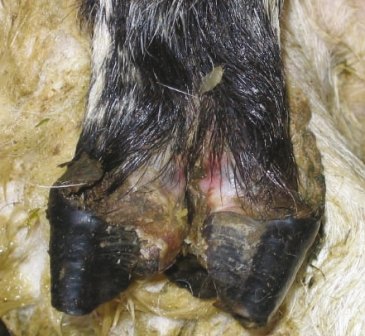Early birds catch the rot!

Autumn and winter always brings with it uncertainty when it comes to weather. When the weather deteriorates the necessity for housing is likely and we’ll start to see an increase in foot problems in sheep. We’re going to give you a rundown of the most common causes of lameness, how to identify them and the best treatment and control strategies.
What causes sheep lameness?
Correct identification of the cause of lameness is important for proper treatment and control. The first lame sheep in a group, even if only mildly lame, should be examined immediately or within three days. In adult sheep the cause of lameness most often originates in the foot so the claws and interdigital cleft should be closely inspected.
What does scald look like?
The skin between the cleats looks pale pink, wet and there may be white pasty scum and hair loss. Predisposed by wet warm weather and poached fields. Can cause severe lameness.
What about foot rot?
Separation of the horn from the underlying tissue starting between the claws (like scald). Foul smelling greyish pus.
Scald and foot rot are caused by the same bacteria. The infection is most commonly passed directly from sheep to sheep but the bugs can survive in the environment for short periods. Damp warm bedding is a perfect place for the bacteria so we often see problems at housing.

Contagious Ovine Digital Dermatitis (CODD)
Separation of the horn at the coronary band (the part of the claw closest to the skin). CODD does not involve the inter-digital space. There is often blood but no significant smell. Sheep are very lame and a large proportion can be affected. This is thought to be caused by the same bug that causes digital dermatitis in cattle.
Toe Granuloma
Strawberry like growth at the toe. May be hidden by loose horn. Often caused by over trimming or secondary to injury.
What’s Shelly Hoof? (white line degeneration)
Partial detachment of the outer hoof wall with the gap becoming full of soil. Half-moon appearance > can progress to an abscess which bursts out above the coronary band.
Treatment
Once you have identified the correct problem there are some rules of thumb for treatment:
- Foot-rot or CODD: prompt identification and treatment with antibiotic spray and one long-acting injection
- Scald: individual cases > antibiotic spray OR treat as above. If group affected foot bathing can help
Remember foot rot, scald and CODD are infectious diseases so where possible separate affected animals from the rest of the flock.
Animals should recover within 2-10 days. If they are not sound in two weeks, they should be re-examined and re-treated. Ideally animals should be culled if they have foot rot more than twice a year.
Trimming
Generally trimming is not necessary. It can have several detrimental effects including spreading disease, delaying healing and causing injury. Even overgrown feet should only be trimmed if it is affecting their ability to walk.
Control
1) Biosecurity
- If buying stock, purchase from farms which are free of foot rot and CODD or have evidence of a good control strategy
- Quarantine: Isolate for at least 21 days, inspect prior to joining flock and ensure there’s no evidence of lameness. Treat where necessary.
- Isolate affected animals and cull those which are unresponsive to treatment
2) Foot bathing: particularly at key times (pre-housing, gathering)
3) Vaccination: a foot rot vaccine is available but this should be used alongside other control strategies. The response can be variable so please discuss this further with your vet.
4) Pasture management:
- Ensure you have a spare isolation field for lame sheep
- The area around water troughs should be well drained
- Feed troughs should be moved regularly to avoid poaching
5) Housing:
- House lame sheep separately
- Footbath all sound sheep prior to housing
- Treat all suspect cases of foot rot/ scald/ CODD
- Provide dry bedding, especially around water/feed troughs
- Avoid high stocking rates
- Change ALL bedding if putting healthy sheep into pens where lame sheep have been kept
For more information on managing lameness in your flock, you should speak to your vet.
- 1st November 2022
